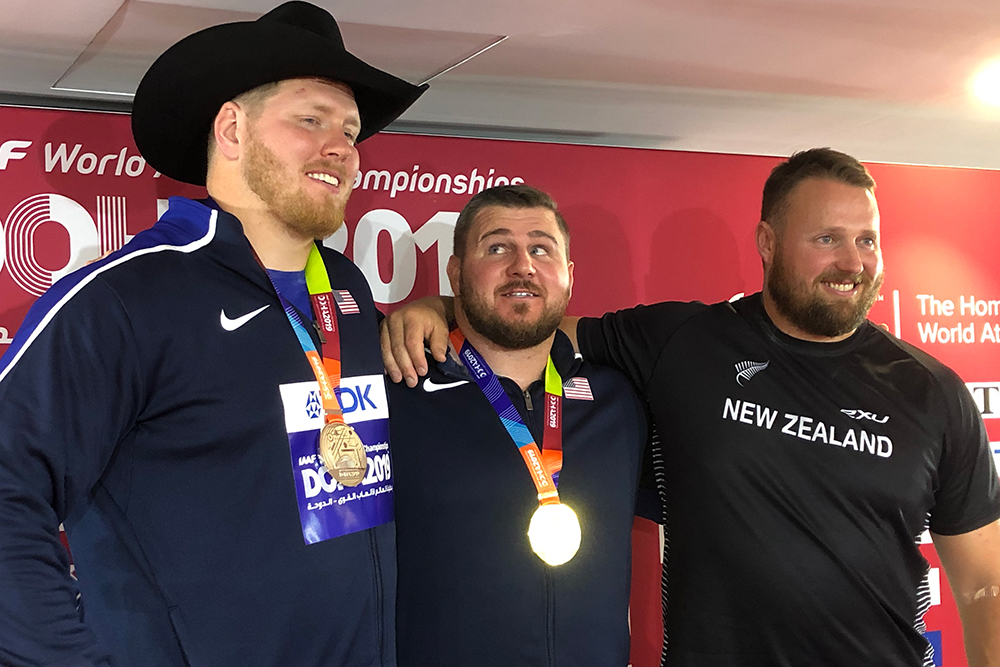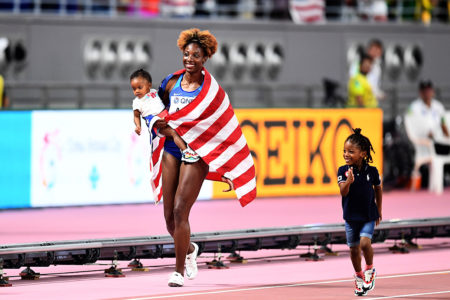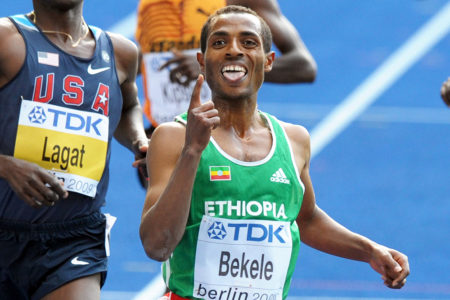
DOHA, QATAR, September 27–October 06—From the moment it was awarded to a small yet fabulously wealthy nation in the Middle East, World Championships XVII promised to match the title of that ’71 classic from the Monty Python oeuvre, And Now For Something Completely Different. Minus the belly laughs but with surreality fully intact: a global title meet for a traditionally summer sport instead staged deep in the autumn yet basted in stultifying heat and humidity not unlike the conditions expected for the Tokyo Olympics next year. Midnight road events, late-evening scheduling generally and an audaciously air-conditioned outdoor Khalifa International Stadium were seen as necessary—and in the case of the women’s marathon and all four walks rather ineffective in the offing—tweaks to make the medicine go down.
Although not totally unexpected, there were vast swaths of empty seats too often—in fairness not throughout, especially after the organizers took to papering the house with free tickets—stole headlines in the media coverage. That was a pity, for the quality of competition and the marks produced were supremely top shelf. It wasn’t just that the women’s 400H (and as expected the new mixed-sex 4 x 400) produced World Records, that the men’s shot was the most epic ever contested, or that winning times in the women’s 400 and 1500 approached WRs from long-ago eras. Remarkably, winning marks in 31 of the 48 events (ignoring the mixed relay, of course) exceeded those that earned gold 2 years ago in London. That’s 64-plus percent. Athletes and coaches sliced through the calendar shift as though it were butter on a plate in Doha at 3:00 a.m. Americans sliced well, winning a near-record 29 medals, a record-equaling 14 of them gold (see sidebar).
Whatever one’s opinion on air conditioning an outdoor arena built by migrant laborers under conditions international rights groups have decried, the AC worked. Temperatures in Khalifa met with athlete approval, interrupted only on the first evening during men’s long jump qualifying when some complained the edifice’s cool air jets made for shifting wind conditions. Silver medal vaulter Sandi Morris’s comments comported with the norm, not exception: “The venue is world-class. It was amazing. The best conditions we’ve had all year. Awesome runway, awesome pit.” Read on for our coverage; you’ll find the results reflected this also.
Nonetheless, conditions for the road events appallingly put every other imaginable lower value above athlete health and safety. Just ask any spectator hardy enough to line the route for the women’s marathon. The listed temp and humidity readings, the same for both the midnight start and finish, were steambath stuff: 90° (32C) with 74% humidity. Heat index, that “feels like” figure served up by your smartphone: 107 (42) in the middle of the night! Twenty-eight of the 68 starters DNFed and winner Ruth Chepngetich’s time was more than 15 minutes slower than she ran in nearby Dubai last winter. Why did an IAAF that bills itself as athlete-forward, presentation-forward, open to new ideas, find it impossible to move these events to a friendlier clime as will apparently happen for the ’20 Olympics road contests?
Whether there was a provably corrupt element to the bidding process that won Doha these Worlds 4 years ago under the, we now know, manifestly corrupt regime of former IAAF President Lamine Diack, remains an unanswered question. But current President Seb Coe’s public position on Doha’s selection has not swayed. The sport, he maintains, must expand from its traditional markets.
“We are going to have to find the navigable path—and, yes, sometimes it will be boulder-strewn,” he told PR Week in ’14. “And it will mean beginning a global conversation that covers political, cultural and economic differences—even a rethink of the sporting calendar. We can no longer sit here and say that new formats and championships in emerging sporting powers can only be held at certain times of the year for fear of clashing with major or more established leagues and climatic inhibitors.”
Qatar, the world’s richest nation per capita, was an obvious partner to court for financial reasons, especially as a World Championships could offer the Arabian Gulf venue a “practice run” for soccer’s far more massive World Cup in ’22. “If we are unwilling to have this conversation,” Coe stated, “I fear that many of these countries that have an appetite to invest in sporting infrastructure both hard and soft will find other priorities, few of which will have the opportunity for a discourse on change.”
Portions of the local population enthusiastically drank in the sporting spectacle. Some 85% of Qatar’s c2.7 million population are foreign guest workers and from this polyglot set Ethiopians, Kenyans, Ugandans, Indians, Pakistanis and others cheered vociferously and made all manner of joyous noise as they watched elite athlete compatriots compete at a rarified level. Home country hero Mutaz Barshim’s triumph in the high jump, of course, made for a highlight evening on the program, one for which the organizers ended up removing tarps covering upper-deck seating.
But with the air-conditioning whirring like a champ, was it necessary to start proceedings so late each evening? Some Doha residents noted it was unrealistic for fans with families to stay till midnight in a country where schools start at 7:00 a.m. The specific timing made it difficult to imagine that worldwide broadcast considerations drove the late hours. One major meet promoter on hand, a professional who knows the nuts & bolts, suggested an overall speedup could work. Simply put, less down time, shave the intervals between heats by a minute or 3.
On the bright side, the event-production team put forward some delightful innovations. Among these were cutting-edge laser lightshow introductions to selected evening-ending finals when concurrent field event competition permitted, a crowd pleaser for those still in the stands, and an improved variety of camera angles to please TV audiences and the in-stadium crowd peering not only at the live view but massive video boards. One invention, wide-angle cameras in the blocks, added an intriguing new perspective but also drew protests from women sprinters. “I find it very unpleasant stepping over these cameras as I get into the blocks wearing these scanty clothes,” sprinter Gina Lückenkemper told the BBC. Several athletes said they received no notification beforehand about the “block cams” or the lights, bells & whistles introductions.
For the first time at an outdoor Worlds—which was also the first without a morning session—medal ceremonies were segregated to standalone blocks of time in the middle of things. The idea was fewer interruptions to the flow of track & field action. In practice, though, many rued hour-long blocks of downtime and medalists perched distantly on podiums visually ant-size and miles above the stadium floor. The policy of no ins and outs to leave the stadium and return during the long sessions clashed with the distribution of free tickets (and even simply waving walk-ups through the gates without tickets). The house-papering, those with full sets of tickets said, led to a churn of folks grabbing free seats and then forcing standups along the aisle moments later as they set off in search of better seats or the exit.
Our sport makes for gloriously engaging entertainment, in its highest incarnation at a Worlds. Doha delivered on that score. Next up Tokyo. And then Eugene ’21. Cross fingers TrackTown can surpass itself for track & field’s crown jewel in the first-ever U.S. hosting.
| Click Here For A Listing Of Medalists With Links To Reports On Each Event |
U.S. Dominates By–Nation Medal Chart
Doha turned out to be a very good World Championships for Team USA, which ended up with 29 total medals: 14 gold, 11 silver, 4 bronze. The total is only 1 off the record set in London 2 years ago, although it must be noted that this time’s total includes the mixed 4×4, which wasn’t conducted then. The 14 golds also equals the all-time high—set jointly at Helsinki ’05 & Osaka ’07—but this year’s total also includes the extra event, so isn’t in reality the all-time best. Here’s the complete chart, which includes the “administrative” bronzes the IAAF awarded in the men’s 110H and hammer:
| Nation | Men | Women | Overall | ||||||
| G | S | B | Total | G | S | B | Total | ||
| United States | 9 | 5 | 1 | 15 | 4 | 6 | 3 | 13 | *29 |
| (*plus mixed-relay gold) | |||||||||
| Jamaica | 1 | 2 | – | 3 | 2 | 2 | 4 | 8 | *12 |
| (*plus mixed-relay silver) | |||||||||
| Kenya | 2 | – | 3 | 5 | 3 | 2 | 1 | 6 | 11 |
| China | – | – | – | – | 3 | 3 | 3 | 9 | 9 |
| Ethiopia | 2 | 4 | – | 6 | – | 1 | 1 | 2 | 8 |
| Germany | 1 | – | 1 | 2 | 1 | – | 3 | 4 | 6 |
| Poland | 1 | – | 3 | 4 | – | 2 | – | 2 | 6 |
| Russia | – | 3 | 1 | 4 | 2 | – | – | 2 | 6 |
| Canada | – | 1 | 4 | 5 | – | – | – | – | 5 |
| Great Britain | – | 1 | – | 1 | 2 | 2 | – | 4 | 5 |
| Bahrain | – | – | – | – | 1 | 1 | – | 2 | *3 |
| (*plus mixed-relay bronze) | |||||||||
| Cuba | – | – | 1 | 1 | 1 | 1 | – | 2 | 3 |
| Japan | 2 | – | 1 | 3 | – | – | – | – | 3 |
| Sweden | 1 | 1 | 1 | 3 | – | – | – | – | 3 |
| Austria | – | – | 1 | 1 | – | – | 1 | 1 | 2 |
| Bahamas | 1 | – | – | 1 | – | 1 | – | 1 | 2 |
| Belgium | – | – | 1 | 1 | – | 1 | – | 1 | 2 |
| Colombia | – | 1 | – | 1 | – | – | 1 | 1 | 2 |
| Estonia | – | 2 | – | 2 | – | – | – | – | 2 |
| France | – | 1 | 1 | 2 | – | – | – | – | 2 |
| Netherlands | – | – | – | – | 2 | – | – | 2 | 2 |
| Qatar | 1 | – | 1 | 2 | – | – | – | – | 2 |
| Uganda | 1 | – | – | 1 | 1 | – | – | 1 | 2 |
| Ukraine | – | – | – | – | – | 2 | – | 2 | 2 |
| Algeria | – | 1 | – | 1 | – | – | – | – | 1 |
| Australia | – | – | – | – | 1 | – | – | 1 | 1 |
| Bosnia | – | 1 | – | 1 | – | – | – | – | 1 |
| Burkina Faso | – | – | 1 | 1 | – | – | – | – | 1 |
| Côte d’Ivoire | – | – | – | – | – | – | 1 | 1 | 1 |
| Croatia | – | – | – | – | – | – | 1 | 1 | 1 |
| Ecuador | – | – | 1 | 1 | – | – | – | – | 1 |
| Greece | – | – | – | – | – | – | 1 | 1 | 1 |
| Grenada | 1 | – | – | 1 | – | – | – | – | 1 |
| Hungary | – | – | 1 | 1 | – | – | – | – | 1 |
| Italy | – | – | – | – | – | – | 1 | 1 | 1 |
| Morocco | – | – | 1 | 1 | – | – | – | – | 1 |
| Namibia | – | – | – | – | – | – | 1 | 1 | 1 |
| New Zealand | – | – | 1 | 1 | – | – | – | – | 1 |
| Nigeria | – | – | – | – | – | – | 1 | 1 | 1 |
| Norway | 1 | – | – | 1 | – | – | – | – | 1 |
| Portugal | – | 1 | – | 1 | – | – | – | – | 1 |
| Spain | – | – | 1 | 1 | – | – | – | – | 1 |
| Switzerland | – | – | – | – | – | – | 1 | 1 | 1 |
| Venezuela | – | – | – | – | 1 | – | – | 1 | 1 |
| 24 | 24 | 26 | 74 | 24 | 24 | 24 | 72 | 149* | |






